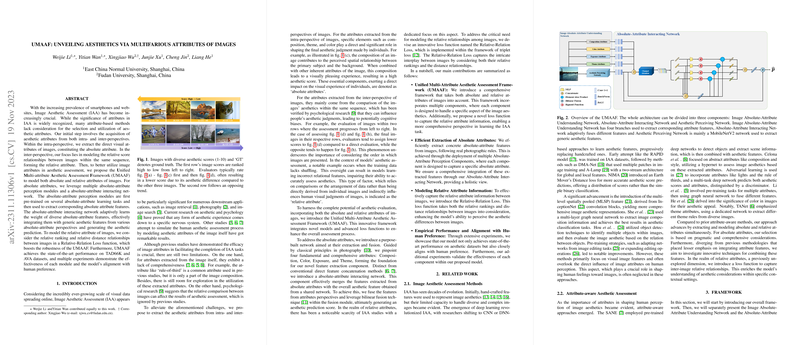UMAAF: Unveiling Aesthetics via Multifarious Attributes of Images
The paper entitled "UMAAF: Unveiling Aesthetics via Multifarious Attributes of Images" presents a sophisticated approach to Image Aesthetic Assessment (IAA) by proposing the Unified Multi-Attribute Aesthetic Assessment Framework (UMAAF). This framework seeks to enhance IAA by integrating both absolute and relative attributes of images, aiming to capture the multilayered facets of image aesthetics.
Overview of the Framework
UMAAF excels by leveraging aesthetic attributes from intra- and inter-perspectives:
- Absolute Attributes: These derive from inherent features within images, such as composition, color, exposure, and theme. The framework utilizes multiple Absolute-Attribute Perception Components, which are pre-trained on specific tasks associated with each attribute. These components extract concrete features from images, which are then adaptively integrated using an Absolute-Attribute Interacting Network. This network provides a sophisticated fusion of absolute features with generic aesthetic features, employing techniques such as channel attention and bilinear fusion.
- Relative Attributes: Drawing inspiration from psychological research, which indicates that the order of image presentation affects aesthetic judgment, UMAAF introduces the Relative-Relation Loss. This novel loss function models the relative ranking and distances among images, enhancing the robustness of the aesthetic evaluation.
Quantitative Results
UMAAF demonstrates impressive numerical results, achieving state-of-the-art performance on significant datasets such as TAD66K and AVA. Notably, on the TAD66K dataset, UMAAF achieved high PLCC and SRCC scores, marking improvements over previous methods like TANet. Similarly, on the AVA dataset, UMAAF outperformed various contemporary approaches in metrics such as PLCC and reduced EMD, indicating strong alignment with human aesthetic judgments.
Implications and Future Directions
The UMAAF framework has notable theoretical and practical implications:
- Theoretical: By employing a comprehensive system that integrates multifaceted attributes, UMAAF advances the understanding of how different elements contribute to image aesthetics. This could spur further investigation into attribute interactions and other aspects of human visual perception.
- Practical: The integration of absolute and relative attributes in aesthetic evaluation presents opportunities for applications such as automated image enhancement, content-based image retrieval, and photo curation.
Speculation on Future Developments
The UMAAF framework opens avenues for expanding AI capabilities in visual aesthetics. Future research could leverage this framework to explore:
- Attribute Selection: Investigating additional aesthetic attributes that may contribute to nuanced aesthetic judgments.
- Model Interpretability: Enhancing transparency in AI decisions, potentially leading to models that can justify their aesthetic evaluations.
With its innovative approach and comprehensive results, UMAAF stands as a significant contribution to the ongoing development of image aesthetic assessment methodologies. It paves the way for more nuanced and human-aligned aesthetic judgments in AI systems.
